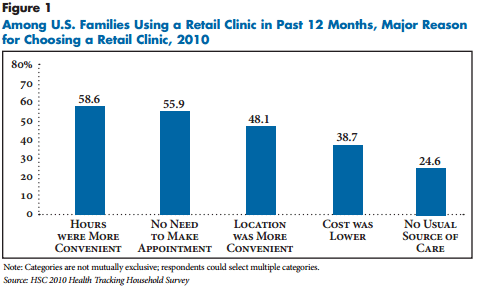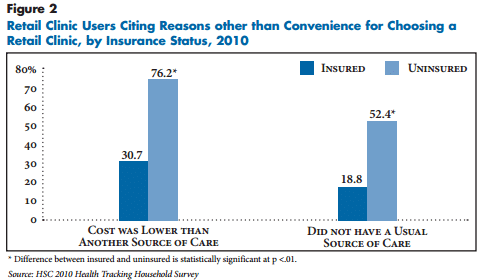We have written previously about what the theory of disruptive innovation predicts regarding the attractive growth prospects of the retail clinic business. However, even if a business model is aligned with the theories of disruptive innovation, execution still matters. A recent study by the Center for Studying Health System Change highlights a few key areas in which retail clinics may more meaningfully integrate around jobs to be done and hone their execution going forward.
To begin, one must understand the theory of jobs-to-be-done. We recently asserted that there are three fundamental patient jobs to be done. For a business model to truly nail a job-to-be-done, it must do three things:
1- Understand and address the job (functionally, socially, emotionally)
2- Create necessary experiences in purchase and use to reduce the friction of consumption, and
3- Integrate around the job to make competition impossible
Retail clinics generally understand and address the job well. They wouldn’t be growing so briskly if they didn’t. However, their ability to create the necessary experiences in purchase and use and integrate around the job leaves room for improvement. The data from the Center for Studying Health System Change’s study reveals some interesting insights about why and how people hire retail clinics to do these jobs and where retail clinics can innovate their offerings to fuel continued success.
First, people hire retail clinics predominantly to accomplish two patient jobs-to-be-done: 1-tell me what’s wrong, and 2-fix me. The data suggests that people want these jobs served at the same time, as quickly and conveniently as possible. This is no surprise given the limited menu of treatment options offered at retail clinics. What may be surprising, however, is that cost appears to be much less important than convenience in doing this job among many current users (saying nothing about non-users).
What does this mean? Perhaps that the experience in purchase and use of convenience (both time and distance-wise) may be worth more to users than clinic operators previously supposed. Convenience users also happen to correlate with demographic groups above 6X the poverty line, which reinforces the idea that a convenience-based value proposition may be more valuable than current operators realize.
If a retail clinic operator wanted to elegantly integrate around the convenience value proposition, they could potentially raise prices without harming utilization. This approach would at the same time reduce demand among users for whom cost is the key experience in purchase in use, but that might be just fine in certain locations or using certain formats.
Second, cost matters to some users, but they are trying to satisfy jobs 1 and 2 under different circumstances than the convenience users. These are people who are uninsured and do not have an affordable regular source of care. It would be easy to claim this group of users will cease to be relevant once the Affordable Care Act is fully implemented. However, even then, there will be groups of users who have “coverage without care.” That is to say, they will have insurance coverage, but will not be able to afford the out-of-pocket costs under that policy for traditional primary care. Thus, here is another group trying to do the same jobs (patient jobs 1 and 2), but with completely different needs in the context of experience in purchase and use. Herein lies another opportunity for clinic operators to integrate around this job with a focus on low-cost experiences in purchase and use. Any retail clinic chain that did this would erect huge barriers to competition at the low end of the market.
When considering jobs to be done, it is tempting to create a product that represents the mean of all users’ requirements or needs. This is the kind of thinking almost always results in a one-size-fits-none product or service and makes you prone to future disruption. As retail clinic operators move forward, they should carefully consider the experiences in purchase and use their users demand (convenience or cost) and boldly discard conventional wisdom by aggressively integrating around those needs.




